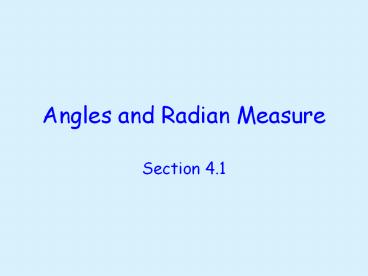Angles and Radian Measure - PowerPoint PPT Presentation
Title:
Angles and Radian Measure
Description:
Angles and Radian Measure Section 4.1 Objectives Estimate the radian measure of an angle shown in a picture. Find a point on the unit circle given one coordinate and ... – PowerPoint PPT presentation
Number of Views:549
Avg rating:3.0/5.0
Title: Angles and Radian Measure
1
Angles and Radian Measure
- Section 4.1
2
Objectives
- Estimate the radian measure of an angle shown in
a picture. - Find a point on the unit circle given one
coordinate and the quadrant in which the point
lies. - Determine the coordinates of a point on the unit
circle given a point on the unit circle. - Find coterminal angles.
- Convert angle measures between radians and
degrees. - Determine the linear speed of an object traveling
in a circular motion. - Determine the arc length on a given circle.
3
Vocabulary
- unit circle
- radian measure of an angle (radians)
- degrees
- vertex of an angle
- terminal side of an angle
- initial side of an angle
- linear speed (length per unit of time)
- length of a circular arc
- angular speed (radians per unit of time)
4
Unit Circle
5
Consider the picture below. The angle ? is an
integer when measured in radians. Give the
measure of the angle.
The angle that is straight up (right) is
approximately 1.571 radian. The straight angle
is approximately 3.142 radians. Since this angle
is closer to the straight angle than to the right
angle, the radian measure would be about 3
radians.
6
Coterminal Angles
Angles are coterminal if they are in standard
position and have the same terminal side.
Since this angle is positive, we need to subtract
multiples of 2p to find a coterminal angle. To
determine how many multiples, we can start by
dividing 77 by 3. This will tell us how many
half circles there are. Since we need full times
around the circle, we need to divide that number
by 2 for how many multiples of 2p we need to
subtract.
continued on next slide
7
Coterminal Angles
Angles are coterminal if they are in standard
position and have the same terminal side.
25 full half-ways around a circle
full times circles
8
Formulas
- Conversion between degrees and radian
- Length of a circular arc
- Linear speed
- Angular speed
9
Find the degree measure of anangle with radian
measure
To convert from radians to degrees, we want to
multiply the radian measure by a fraction made up
of radians and degrees equal to 1. Since we are
trying to get rid of the radians, we will need
the fraction to have radians in the denominator.
Since 180 degrees is the same as p radians, we
will use these two numbers in our fraction.
10
Find the radian measure of anangle with degree
measure
To convert from degrees to radian, we want to
multiply the degree measure by a fraction made up
of radians and degrees equal to 1. Since we are
trying to get rid of the degrees, we will need
the fraction to have degrees in the denominator.
Since 180 degrees is the same as p radians, we
will use these two numbers in our fraction.
11
Find the length of the arc on a circle of radius
r 6 inches intercepted by a central angle ?
135 degrees
For this problem, we will use the formula for the
length of a circular arc.
In order to do this, we must change the angle
measure to radians.
Now we can plug this into the formula to get
12
A Ferris wheel has a radius of 30 feet and is
rotating at 3.5 revolutions per minute. Find the
linear speed, in feet per minute, of a seat on
the Ferris wheel.
For this we will need the linear speed formula.
We will need to calculate s (the length of the
circular arc that the Ferris wheel goes through
and find the time t that is takes to go through
that arc. The Ferris wheel goes through 3.5
revolutions in one minute. This means that the
angle is 3.5 times around the circle. Since one
time around the circle is 2p radians, we need to
multiply 3.5 by 2p to find the radian measure of
the angle.
continued on next slide
13
A Ferris wheel has a radius of 30 feet and is
rotating at 3.5 revolutions per minute. Find the
linear speed, in feet per minute, of a seat on
the Ferris wheel.
This will give us a radian angle measure of 7p.
We now use that in the formula for s to find the
length of the circular arc.
Now the amount of time that the Ferris wheel took
to go that 210p feet was 1 minute. This means
that to find the linear speed, we divide the
distance by the time it took to travel that
distance. This will give us































